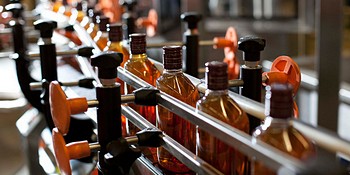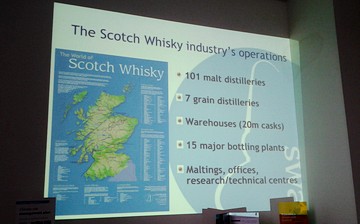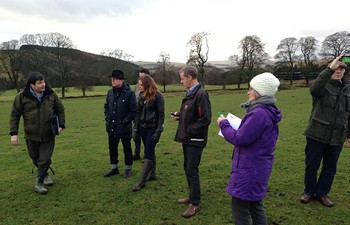A field trip by businesses and municipal officials from Skåne County, in southern Sweden, offers insights for SEI research on how companies are addressing supply-chain risks.

Climate change is a growing concern for businesses that depend on agricultural products, such food and drink companies, as their supply chains are often highly exposed to extreme weather, pests, and other risks that are increasing around the world.
SEI Research Fellow Magnus Benzie is working on several projects (see links at right) that examine how companies perceive those risks, what measures they are taking to mitigate those risks, and how policy interventions might promote adaptation.
When the “A Changing Climate for Business” project, which SEI advises, organized a field trip to Scotland on 5-9 February, Benzie joined the group, aiming to learn both from the Scots, and from his fellow travelers. Below, Benzie shares some of his observations.
Q: What did the trip entail?
A: We met with representatives of the Scotch Whisky Association as well as the head of environment for Diageo Global, which owns about 30% of the Scotch whisky industry as well as several other major drink brands worldwide. In addition, we met with Scottish government and business representatives, and with Adaptation Scotland, a nonprofit working to support public- and private-sector adaptation. We also visited a site in the Borders of Scotland, where an innovative scheme to improve natural flood water management has brought together farmers, local partnerships and local councils to protect towns from increasing flood risk. And the group visited Newcastle, in northeast England, to visit a business undertaking adaptation and meet the regional climate change partnership, which has led some studies on the economics of regional adaptation to climate change.
Q: How much progress have Scottish companies made on adaptation?
A: A lot. This is most prominent in the £4 billion whisky industry, which employs 35,000 people in Scotland and is growing rapidly, driven largely by growing demand from emerging economies. Whisky has very long-term planning horizons, as it requires expensive infrastructure investments and it can take 20 years or more for good, high-value whisky to mature. Another key feature of the whisky industry is its direct reliance on agricultural produce (mostly high grade malting barley, but also other grains) and water, which also entails long-term horizons and significant exposure to climatic risks.

Q: What has driven progress on adaptation?
A: It has been the result of collaboration between companies, the trade association (and their dedicated research arm, the Scotch Whisky Research Institute), and the Scottish Government. There is a lot of information-sharing on how to approach environmental issues, and this has extended to adaptation. The local nature of many impacts (e.g. flood vulnerability of specific warehouses) has led companies to see many of these issues as non-competitive, and their shared reliance on vulnerable inputs such as barley has led them to jointly fund research into new strains of resilient barley, for example. It was interesting for the Swedish visitors to talk about how intra-industry and public-private exchanges and coordination could advance adaptation in the Swedish context as well.
Q: How much have whisky-makers prioritized adaptation?
A: Climate risks are being managed at the highest corporate, strategic level in some of the major companies that control most whisky distilleries. Companies are being encouraged to recognize climate-related risks on their Strategic Risk Registers.
In large companies like Diageo, issues like water scarcity and future climate impacts on crops are concerns at the global level, not just for sites and operations on the ground. This is especially evident where these global companies are operating – and expanding – in water-constrained areas such as sub-Saharan Africa and the Indian sub-continent. Diageo is experimenting with new crops for beer production (e.g. sorghum and cassava), which are require less water to grow and to process.
These measures are rarely referred to as “adaptation”, but not only do they reduce supply-chain risks, but they are also designed to deliver local benefits, such as by employing local farmers. It is striking to see large multinationals such as Diageo entering into these new kinds of partnerships with their competitors and with NGOs and local organizations to manage scarce water resources, in ways that they say were not even being dreamt of 5 or 10 years ago.

Q: Why are companies innovating like this?
A: Awareness of risk within the highest levels of whisky and global drinks companies is one key driver. Investors are also asking companies what they are doing to mitigate growing risks around natural resources – especially water. At the moment this happens most frequently in developing countries and emerging markets where resource risks are more obvious. But companies such as Diageo are also motivated to perform well by new indices and indicators, such as those from the CDP initiative, which asks new questions and challenges companies to understand risks and be proactive.
Q: How much could Scotland and Sweden learn from each other?
A: Adaptation Scotland is hoping to build a greater understanding of climate risks across supply chains, and we expect the Changing Climate for Business project to offer valuable insights. It is working with a wide range of representatives from food and drink supply chains, from primary farmers and land managers, through food processors to major food brands that buy from contract farms and deliver packaged foods direct to supermarkets. The intention is to gain a much broader understanding of the distribution of risk across actors within supply networks, the measures that need to be taken at various scales, and the collaborations that may be required.
Companies in both Scotland and Sweden also have to face the possibility that climate change will affect domestic production of key supplies. Whisky producers have already had to buy barley from outside the UK after poor domestic harvests, and Sweden has sold malting barley to Scotland in the past. In the future, it may need to rely even more on trading partners with similar climates – or with climate similar to how the Scottish climate “used to be”.
I heard the same kinds of concerns from a senior agricultural advisor for a major Swedish food brand. He said right now, the best place to grow vegetables for the company’s products is Sweden, especially given the increasingly erratic climatic conditions in some other European countries. But where will the best place to grow those vegetables be in 15 to 20 years’ time?
Learn more about the SEI project Adaptation Without Borders »
Learn more about Mistra-SWECIA-funded SEI research on supply-chain risks »

Design and development by Soapbox.
